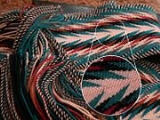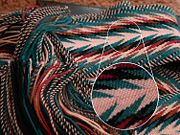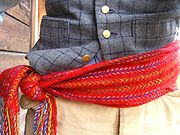
Ceinture fléchée
Encyclopedia


Sash
A sash is a cloth belt used to hold a robe together, and is usually tied about the waist. The Japanese equivalent of a sash, obi, serves to hold a kimono or yukata together. Decorative sashes may pass from the shoulder to the hip rather than around the waist...
, a traditional piece of French-Canadian clothing of the 19th century (of the Lower Canada
Lower Canada
The Province of Lower Canada was a British colony on the lower Saint Lawrence River and the shores of the Gulf of Saint Lawrence...
, Canada East
Canada East
Canada East was the eastern portion of the United Province of Canada. It consisted of the southern portion of the modern-day Canadian Province of Quebec, and was primarily a French-speaking region....
and early confederation
Canadian Confederation
Canadian Confederation was the process by which the federal Dominion of Canada was formed on July 1, 1867. On that day, three British colonies were formed into four Canadian provinces...
eras). The Métis
Métis people (Canada)
The Métis are one of the Aboriginal peoples in Canada who trace their descent to mixed First Nations parentage. The term was historically a catch-all describing the offspring of any such union, but within generations the culture syncretised into what is today a distinct aboriginal group, with...
also made ceintures fléchées and use them as part of their national costume
National costume
Folk costume expresses an identity through costume which usually to a geographic area or a period of time in history, but can also indicate social, marital and/or religious status...
.
History
In Quebec, this wool sash was used by men to tie jackets around their waists to prevent the cold from creeping in. It was a both practical and fashionable accessory, worn by both the bourgeois and the habitant classes. The width of a traditional belt can be 15 centimetres to 25 centimetres, and its length can easily be more than 2 metres. The ceinture also had a practical use: it helped prevent back injuries or hernias amongst the fur traders of the time.It is adorned by an arrow
Arrow
An arrow is a shafted projectile that is shot with a bow. It predates recorded history and is common to most cultures.An arrow usually consists of a shaft with an arrowhead attached to the front end, with fletchings and a nock at the other.- History:...
ed pattern and was worn around the winter coats of the time. It is also a symbol of the Lower Canada Rebellion
Lower Canada Rebellion
The Lower Canada Rebellion , commonly referred to as the Patriots' War by Quebeckers, is the name given to the armed conflict between the rebels of Lower Canada and the British colonial power of that province...
and the Quebec Winter Carnival, as it is worn by the festival mascot, Bonhomme Carnaval. Imitations are sold and seen throughout the carnival. The belt is represented in a number of artistic creations, such as the illustration Le Vieux de '37
Le Vieux de '37
Le Vieux de '37 is the name under which is known an illustration by Henri Julien created approximately in 1880 to illustrate Le vieux patriote, a poem from Louis Fréchette.It depicts a participant of the Lower Canada Rebellion of 1837 and 1838 which sought to make of Lower Canada Le Vieux de '37...
by Henri Julien
Henri Julien
Henri Julien, baptised Octave-Henri Julien was a French Canadian artist and cartoonist noted for his work for the Canadian Illustrated News....
, the painting L'Assemblée des six-comtés
L'Assemblée des six-comtés (painting)
L'Assemblée des six-comtés , also known as Manifestation des Canadiens contre le gouvernement anglais, à Saint-Charles, en 1837 , is a large oil painting executed on canvas by Ontario artist Charles Alexander Smith in 1890.It depicts...
by Charles Alexander Smith
Charles Alexander Smith
Charles Alexander Smith was a Canadian painter from Ontario.- See also :*Assemblée des six-comtés *List of Canadian painters*List of Canadian artists-External links:* at artnet...
and the song Mon Pays, suivi du Reel des Aristocrates from néo-trad
Néo-trad
Néo-trad is a musical style from Quebec that arose around the turn of the 21st century. It can be considered a subgenre of Québécois Trad music. The term combines the Greek prefix neo, meaning new, and the contraction of the word traditionnelle, as in traditional music.It basically constitutes...
musical band Les Cowboys Fringants
Les Cowboys Fringants
Les Cowboys Fringants are a popular band and cult phenomenon from Quebec, who perform Québécois néo-trad music , the band also draws on Country music. They have gained an international underground following, especially in France, French-speaking Belgium and Switzerland...
.
The arrow sash was part of the traditional costume of the Lower Canada habitant at least from 1776 on. Although at that time the British visitors and the German merceneries who noticed its presence called it a "coloured sash". That is what Thomas Anbury called it when he wrote his account of travel after his visit to Charlesbourg and Beauport in 1776. In 1777, Charlotte Luise de Riedesel, arriving from Germany to rejoin her husband, Major-General Frederick, related that when she met him in Chambly
Chambly, Quebec
Chambly is a city in southwestern Quebec, Canada, about to the south east of Montreal.- Geography :It sits on the Richelieu River in the Regional County Municipality of La-Vallée-du-Richelieu, at .-History:...
, he was wearing a red and blue sash with fringes over the traditional Canadian costume to keep him warm as he was still suffering from influenza. That same year, a German mercenery lodged at Sainte-Anne related how people in their home were weaving the colored sashes using their domestic wool. In 1778, E.V. Germann made a drawing showing clearly a Canadian peasant wearing his sash, the design was a chevron. That drawing is a proof of what is written by others. Elisabeth Simcoe who lived in Quebec city in 1792 for more than a year wrote about the Canadians, "(…) their coats are tied round with a coloured sash."
When in 1798, the corpse of a drowned voyageur
Voyageurs
The Voyageurs were the persons who engaged in the transportation of furs by canoe during the fur trade era. Voyageur is a French word which literally translates to "traveler"...
was founded along the St. Lawrence River, in Verchères, Labadie wrote in his personnel diary that the voyageur was wearing "…une jolie cinture à flesche" Also in 1798, the inventory after death of Mrs Chaboillez, whose husband, Charles, was one of the founders of the Beaver Club, numbered "deux cintures à flesches" In 1806, the British John Lambert after having visited many villages wrote that five habitants out of six wore a colored sash. He even specified that sometimes the sash was decorated with pearls. The sash was changing in its design, but this cannot be attributed to anyone in particular.
The coloured sash was brought to western Canada by the men working for the North West Company
North West Company
The North West Company was a fur trading business headquartered in Montreal from 1779 to 1821. It competed with increasing success against the Hudson's Bay Company in what was to become Western Canada...
. These voyageurs wore their sashes when leaving Lower Canada and travelling for the fur company. Their sashes attracted the attention of several nations with whom they exchanged goods and soon these people wished to possess such sashes. The company then had many sashes woven in Montreal and area with the fine worsted
Worsted
Worsted , is the name of a yarn, the cloth made from this yarn, and a yarn weight category. The name derives from the village of Worstead in the English county of Norfolk...
wool it imported from England. Beside the NWC, the Hudson's Bay Company
Hudson's Bay Company
The Hudson's Bay Company , abbreviated HBC, or "The Bay" is the oldest commercial corporation in North America and one of the oldest in the world. A fur trading business for much of its existence, today Hudson's Bay Company owns and operates retail stores throughout Canada...
also became interested in that barter article. One of its agents made a request to satisfy that wish. He wrote : "…worsted of colour to make sashes of the latter I have got sample of from my neighbour which will send home". His neighbour was Charles Boyer of the NWC. The sashes adopted by the Indians and the Métis, sons of the voyageurs, are still favoured. They even name it their identity symbol. However, quite often the so-called Métis sashes are not the authentic hand-woven sashes but the kind woven on loom in England probably to meet the requests at lower cost. This can be read in the HBC archives.
The design of the sash continue to be modified and finally became a standarded type that was mainly produced in L'Assomption region around 1835, according to the historian Mason Wade. The HBC agents who came to collect them at Fort Assomption named these sashes lassomption or l’Assomption sash in the accounting books.
Despite its great popularity in Lower Canada as well as in the West, there was a slow-down in its production. That was probably due to the decline of the fur trade in 1870 and in part to the suggestion of the parish priest Tancrède Viger to the weavers, to stop producing, considering them very badly paid for their work.
Sashes were worn by snow-shoers and by retired fur traders who took residence in Montreal and area. Many artists left drawings, paintings and sketches confirming the popularity of the sash. A few women continued weaving sashes and ensured the handing-down of the craft to other generations and the current one.
Marius Barbeau was very interested in ceinture fléchée trying to find its origin. He did not, but left many clues to learn more of its presence, popularity if not its origin. E.Z. Massicotte, archivist at Montreal City Hall and folklorist, continued Barbeau's research and concluded: "la ceinture fléchée un chef d’œuvre de l’industrie domestique du Canada" Since 1968 many persons learned to hand weave ceintures fléchées though not all kept weaving sashes, many taught the craft and are spreading its knowledge. Many popular singers, folklore dancers and especially Bonhomme Carnaval are contributing to make it known to visitors and in various countries.
How to do
Many steps are required in the creation of a ceinture fléchée (also known as an "Assomption sash"). First, the craftmaker picks the wool threads that he needs. The threads have to be long enough so that the person who will wear the sash can pass it twice around the waist. The craftmaker needs to add the length of the fringes at each end of the belt. The fringes are used to tie the arrow sash.After that, the craftmaker organizes the threads and weaves them to create designs of lightning bolts (zigzags), flames (lozenges) and arrow heads (often in the middle of the sash).
Finally, the craftmaker finishes the belt by making twists or braids with the length of thread that remain, to make the fringes.
It can take more than 350 hours to make a sash. That explains its beauty and its cost.
People often confuse authentic handmade ceintures fléchées and machine-woven sashes. A woven sash usually does not cost more than $50. However, a real handmade belt is more durable than a machine-woven one, often made with synthetic fibres (nylon, polyester).
In the creation of a perfect ceinture fléchée or the intricate beadwork designs that would adorn various artifacts a hard callus develops on the tips of the finger. This is referred to as a "needle finger". It is considered a "rite of passage" for young girls and is acknowledged by the matriarchs in the family.
See also
- Folk costume
- Culture of QuebecCulture of QuebecThe Culture of Quebec emerged over the last few hundred years, resulting from the shared history of the French-speaking majority in Quebec. It is unique to the Western World; Quebec is the only region in North America with a French-speaking majority, as well as one of only two provinces in Canada...
- Lower Canada RebellionLower Canada RebellionThe Lower Canada Rebellion , commonly referred to as the Patriots' War by Quebeckers, is the name given to the armed conflict between the rebels of Lower Canada and the British colonial power of that province...
- Quebec Winter Carnival
- Metis people (Canada)Métis people (Canada)The Métis are one of the Aboriginal peoples in Canada who trace their descent to mixed First Nations parentage. The term was historically a catch-all describing the offspring of any such union, but within generations the culture syncretised into what is today a distinct aboriginal group, with...
Specialized references in textiles
- Emery, Irene,(1966). The Primary Structures of Fabrics, The Textile Museum Washington, D.C.
- Burnham, DOrothy, K., (1976). Braided "Arrow" sashes of Quebec. Emery Roundtable at the Textile Museum of Washington, D.C. (with the presence of Noemi Speiser). Dorothy Burnham is an historian in textile, Canada. She start working at the Royal Ontario Museum in 1929 as a second assistant "draftsman" and became its first curator. She is an authority in textile history.
- Burnham, Dorothy K., (1981). The Comfortable Art: Tradition Spinning and Weaving in Canada. Chapter 2. Indian and French Braiding, National Museum of Canada, Ottawa. En français, L'art des étoffes: filage et tissage traditionnels au Canada. Chapitre 2. Indian and French Braiding, National Museum of Canada, Ottawa.
- Speiser, Noémi, (1983). The Manual of Braiding. Published by the author, Basel. Switzerland. Reedition:1988-1991-1997. Noémi Speiser is an international authority on Braids, having researched the subject over 35 years.
Bibliography
Monique Genest LeBlanc :Mémoire de Maîtrise : La ceinture fléchée au Québec, 1991, un. Laval, Québec. Ethnologie des Francophones en Amérique du Nord, département d’Histoire, faculté des Lettres
Monique Genest LeBlanc : Thèse de doctorat : Introduction de la ceinture fléchée chez les Amérindiens : création d’un symbole de statut social, 1996, Un. Laval, Québec,
Monique Genest LeBlanc : « Une cinture à flesche » Sa présence au Bas-Canada, son cheminement vers l’Ouest, son introduction chez les Amérindiens. 2003, Les presses de l’université Laval, Québec
External links
- Sash Weaver, personal Web site of sash weaver Carol James, author of the book Fingerweaving Untangled, containing instructional videos and other resources.
- Étchiboy, Métis company that weaves sashes on looms.
- MiLan Metis Healing Art Project - MMHAP
- Artisant du Fléché Lessons on different technical fabrication of the Fléché motifs
- Artisans et artisanes de ceinture fléchée du Québec (Canada) Learn more about real arrow sash (history, craftmakers, teaching lessons, exhibits, demonstrations, etc.)

